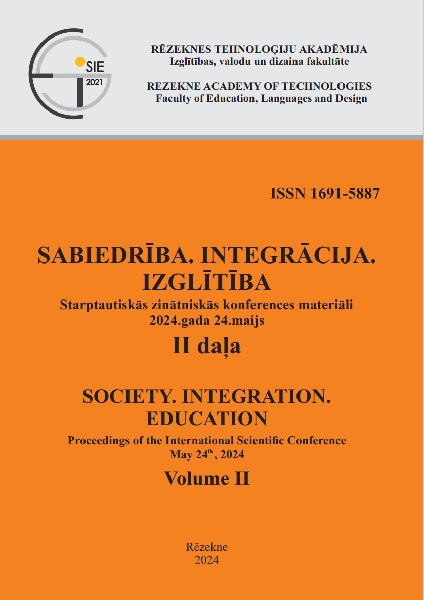WORKING CAPACITY FOR PERSONS WITH MUSCULOSKELETAL DISORDERS
DOI:
https://doi.org/10.17770/sie2024vol2.7857Keywords:
absenteeism, musculoskeletal disorders, presenteeism, quality of lifeAbstract
Musculoskeletal disorders (MSDs) are prevalent globally and result in substantial personal distress and significant social expenses for businesses and society. The ageing population and labor shortages exacerbate these effects. The aim of this study is to investigate the impact of MDS on employment absenteeism and presenteeism. Two instruments, the EQ-5D and the iPCQ, were used to quantitatively survey the Latvian population. 949 respondents of working age were surveyed. From this group, 553 respondents with MSD were selected, averaging 47 years old, 50.6% of whom were men. The results showed that 7.23% experienced absenteeism in the last month. Additionally, 45.9% reported discomfort at work due to MSDs. The EQ-5D-5L questionnaire revealed a decline in health-related quality of life with increasing age, highlighting the significance of addressing the aging workforce and promoting health preservation. 38.3% of respondents with MSDs received rehabilitation interventions, which showed a moderate association with health-related quality of life. The study showed that there is a negative correlation between health-related quality of life and productivity loss. This highlights the importance of comprehensive interventions that address both the physical and psychological aspects of MSDs. The findings offer valuable insights for policymakers, employers, and healthcare professionals to design targeted interventions that improve the health and productivity of individuals with MSDs.
References
Bārzdiņš, J., Konstance, R. (2018). LM, LU, Medicīnas fakultātes Veselības vadības un informātikas centrs. Muskuļu un skeleta sistēmas slimību izmaksu novērtēšana un rekumendācijas izmaksu optimizācijai: Pieejams: https://www.lm.gov.lv/lv/media/14696/download?attachment
Beemster, T.T., Beemster, T.T., Jvan, Velzen, J.M., van, Bennekom C.A.M., Reneman, M.F., Frings-Dresen, M.H.W. (2019). Test-Retest Reliability, Agreement and Responsiveness of Productivity Loss (iPCQ-VR) and Healthcare Utilization (TiCP-VR) Questionnaires for Sick Workers with Chronic Musculoskeletal Pain. Journal of Occupational Rehabilitation, 29(1), 91-103. doi:10.1007/S10926-018-9767-9
EuroQol Research Foundation. (2024). Euroqol.org. Retrieved from https://euroqol.org/eq-5d-instruments/eq-5d-5l-about/
de Kok, J., Vroonhof, P., Snijders, J., Roullis, G., Martin Clarke, M., Peereboom, K., van Dorst, P., & Isusi, I. (2019). European Agency for Safety and Health at Work. Retrieved from https://osha.europa.eu/en/publications/work-related-musculoskeletal-disorders-facts-and-figures-synthesis-report-10-eu-member
GBD 2019 Child and Adolescent Communicable Disease Collaborators. (2023). The unfinished agenda of communicable diseases among children and adolescents before the COVID-19 pandemic, 1990–2019: a systematic analysis of the Global Burden of Disease Study 2019. The Lancet, 402(10398), 313-335. doi:10.1016/S0140-6736(23)00860-7
Hansen, J.A.L., Fast, T., & Wangen, K.R. (2023). Productivity Loss Across Socioeconomic Groups Among Patients With Low Back Pain or Osteoarthritis: Estimates Using the Friction-Cost Approach in Norway. Pharmacoeconomics, 41(9), 1079-1091. doi: 10.1007/s40273-023-01269-4
institute for Medical Technology Assessment. (2024). iMTA. Retrieved from https://www.imta.nl/questionnaires/ipcq/
Johns, G. (2010). Presenteeism in the Workplace: A Review and Research Agenda. Journal of Organizational Behavior, 31, 519-542. doi:10.1002/job.630
Karanika-Murray, M., & Biron, C. (2020). The health-performance framework of presenteeism: Towards understanding an adaptive behaviour. Human Relations, 73(2), 242-261. doi:10.1177/0018726719827081
Koń, B., Jakubczyk, M. (2023). Measuring the Indirect Cost of Illness Using EQ-5D-5L While Accounting for Job Characteristics. PharmacoEconomics, 41, 1051–1064. doi:10.1007/s40273-023-01267-6
Krol, M., Hosseinnia, N., Brouwer, W., & van Roijen. L.H. (2023). Multiplier Effects and Compensation Mechanisms for Inclusion in Health Economic Evaluation: A Systematic Review. Pharmacoeconomics, 41(9), 1031-1050. doi:10.1007/s40273-023-01304-4
Laszewska, A., Sajjad, A., Simson, J., van, Busschbach, J., Hakkaart-van, Roijen, L. (2020). Conceptualisation of Supra-National Value Sets for the EQ-5D. Pecunia. Retrieved from https://www.ispor.org/docs/default-source/default-document-library/ispor-slides-_judit-simon.pdf?sfvrsn=363f9125_0
Latvijas produktivitātes ziņojums 2022. (2023). LU Biznesa, vadības un Ekonomikas fakultātes Produktivitātes zinātniskais institūts. Rīga. Pieejams: https://www.em.gov.lv/lv/media/16764/download?attachment
Lohaus, D., Habermann, W. (2019). Presenteeism: A review and research directions. Human Resource Management Review, 29(1), 43-58. doi:10.1016/J.HRMR.2018.02.010
Ludwig, K, Ramos-Goñi, J.M., Oppe, M., Kreimeier, S., & Greine, W. (2021). To What Extent Do Patient Preferences Differ From General Population Preferences? Value in Health, 24(9), 1343-1349. doi:10.1016/j.jval.2021.02.012.
Ļevina, J., Freimane, G. (2019). Veselības uzvedība. No K.Mārtinsone, V.Sudraba (red.) Veselības psiholoģija. Teorijas un prakses strapdisciplinārā perspektīva. (lpp. 205-237). Rīga: RSU.
Moley, P. J. (2022). MSD Manual. Retrieved from Profesional Version: https://www.msdmanuals.com/professional/musculoskeletal-and-connective-tissue-disorders/neck-and-back-pain/evaluation-of-neck-and-back-pain
OECD and European Observatory on Health Systems and Policies. (2022). Latvijas: Valsts veselības pārskats 2021. doi:10.1787/11bb880a-lv
Ray, M., Merrill., Steven, G., Aldana., James, E., Pope., David, R., Anderson., Carter, Coberley., R., William, Whitmer. (2012). Presenteeism According to Healthy Behaviors, Physical Health, and Work Environment. Population Health ManagementPopulation Health Management, 15(5), 293-301. doi:10.1089/POP.2012.0003
WHO. (2022). Fact sheets. Musculoskeletal health. Retrieved from World Health Organization: https://www.who.int/news-room/fact-sheets/detail/musculoskeletal-conditions
World Bank. (2020). Disability Policy and Disability Assessment System in Latvia. Ziņojums Nr.: AUS0001961. Retrieved from https://www.lm.gov.lv/lv/media/19877/download?attachment






